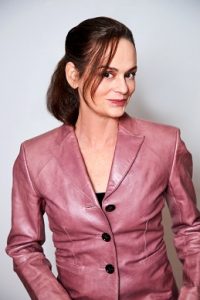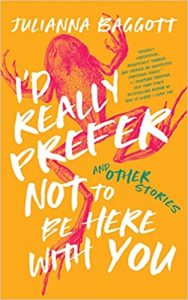My Creative Process: Julianna Baggott
 My creative process doesn’t have edges. I am writing all the time. I experience the world as me but simultaneously as an artist looking for moments when the story world and the actual world bounce light off of each other. I am constantly running a story in my head, sometimes a few of them. I am constantly collecting moments from life to hoard for the next story.
My creative process doesn’t have edges. I am writing all the time. I experience the world as me but simultaneously as an artist looking for moments when the story world and the actual world bounce light off of each other. I am constantly running a story in my head, sometimes a few of them. I am constantly collecting moments from life to hoard for the next story.
It can start with an image—and I don’t know where it belongs in a story but I keep it until I do. Sometimes that takes years.
There can also be an idea that is immediately clear; I know what genre it fits into and a three act structure pops into my head. But then I need hundreds of smaller ideas to build the story into something real, that exists as its own world.
I rely on my subconscious; I dream story.
I rely on memory; I dredge up story.
I rely on my intellect; some projects require a lot of research and also I build structures using what I’ve been taught about story abstractly.
I rely on what seems like instinct but is actually experience; I know what will be the stronger choice because I’ve been here before; I’ve learned how to upend.
All of this said, my days are rigid because I’ve finally gotten to a place where I can be more rigid. Raising four kids and being a professor for a couple decades meant I had to create a very agile and portable process, which ultimately made me more prolific. But I’m relieved I don’t have to struggle so hard to get time at the desk.
I tend to go to bed late and wake up at the same time every morning. I eat relatively healthy meals without much variation. I tend to wear the same few outfits, even when they don’t make much sense. I don’t put much time into my appearance except when I have to. I tend to exercise and take showers (which are good for me creatively) timed to boost my creative process. I sometimes write with music but I don’t overuse it and it’s intentionally chosen and for a set period of time. I break down revision elements into different categories (a ten-minute fix on a small section to something that will require sustained focus, something big and bulky) so I can work even when I only have ten-minutes and know when I’ll need a chunk of time.
I seek out critique. I have a bunch of readers I rely on for notes. They’re brilliant, and the tougher the notes the better I feel. Light notes scare me. Heavy notes give me something to work with. Each project usually goes through many rounds of revision. Some revision cycles are very long, over a year—or, if I have to let it sit, many years. Others are relatively short, a few weeks. Some projects come out nearly whole, and others change dramatically. But it’s not consistent. Big changes can be fast and small changes can take time, impossible to predict. I’m sometimes waiting to understand the needs of the story and then I have a lot of things I do in order to find fixes—a whole long list.
I still get interrupted all the time; I have a big family; I live near my aging parents and I’m close to my kids and extended family; I work with my husband all day long; I mentor; I do some advocacy; there are lots of dogs; the business side of writing is consuming… I don’t mind interruption, usually, because it’s how my process was forged.
I probably have hypergraphia—I write to understand and take a lot of notes in order to hold information. My hands are very tightly and complexly wired to my brain.
I definitely have hyperfocus. My father had this too. Whatever I’m doing at the time has my attention. Whoever I’m with in a moment has my attention. To compensate, I set a series of alarms and make lots of to-do lists. People sometimes mistake this for being very organized but they’re really seeing well-earned coping mechanisms. Everyday life, the regular things, sometimes slip past me because my brain is working in a duality – or with multiple projects, a multiverse – but this is the aspect of writing that I love the most, how it’s not separate but within me.
That said, there’s the moment, inevitably, when the project leaves me—and the process that story has carved out inside of me ends—and the project becomes a product. Art, when money is involved, becomes a commodity. This is when I say goodbye to it emotionally. It’s hard and at the time when a lot of people start to get excited about sharing it with the world, I tend to say goodbye and snip all the wires that connect the story to my heart—like I’m diffusing a bomb.
It’s no longer mine—to the greatest degree I can get there—it’s yours.
And I make sure that when this hand-off happens, I’m deep in another project—another world that will hold me.
—
Julianna Baggott, critically acclaimed and bestselling author, has published more than twenty books under her own name as well as pen names, including two New York Times Notable Books of the Year: Pure, an ALA Alex Award winner, and Harriet Wolf’s Seventh Book of Wonders. Over one hundred foreign editions of her books have been published overseas. Her work is currently in development with Disney+, MGM, Paramount, and Netflix. She’s written for O, The Oprah Magazine; NPR; and the Washington Post.
Find out more about Julianna on her website https://juliannabaggott.com/
I’d Really Prefer Not to Be Here with You, and Other Stories
Bestselling author Julianna Baggott delivers her mind-bending debut short-story collection, featuring an array of genres populated by deeply human characters, and with film rights to the stories already having been sold to Netflix, Paramount, Amblin, Lionsgate, and others!
 In the title story, set five minutes in the future where you not only have a credit score but also a dating score, a woman who’s been banished from all dating apps attends a weekly help group with others who have been “banned for life,” and finds herself falling in love. In “Backwards,” a twist on Benjamin Button, a woman reconnects with her estranged father as he de-ages ten years each day they spend together.
In the title story, set five minutes in the future where you not only have a credit score but also a dating score, a woman who’s been banished from all dating apps attends a weekly help group with others who have been “banned for life,” and finds herself falling in love. In “Backwards,” a twist on Benjamin Button, a woman reconnects with her estranged father as he de-ages ten years each day they spend together.
In “Welcome to Oxhead,” all the parents in a gated community “shut off” when the power goes out. In “Portals,” a small town deals with hope and loss when dozens of portals suddenly open. In “The Now of Now,” two teenagers who can literally stop time find themselves falling in love. In “How They Got In,” a grieving family starts to see a murdered girl in all of their old home videos. In “The Versions,” two stand-in androids fall in love at a wedding, even though they’re not programmed to have emotion. And many other stories of the weird and wonderful.
BUY HERE
Category: How To and Tips
























This is such a great piece! I’ve never thought of my process in quite this way, but it all feels very, very familiar. Leave it to Julianna Baggott to express it so clearly and eloquently. I love her work.